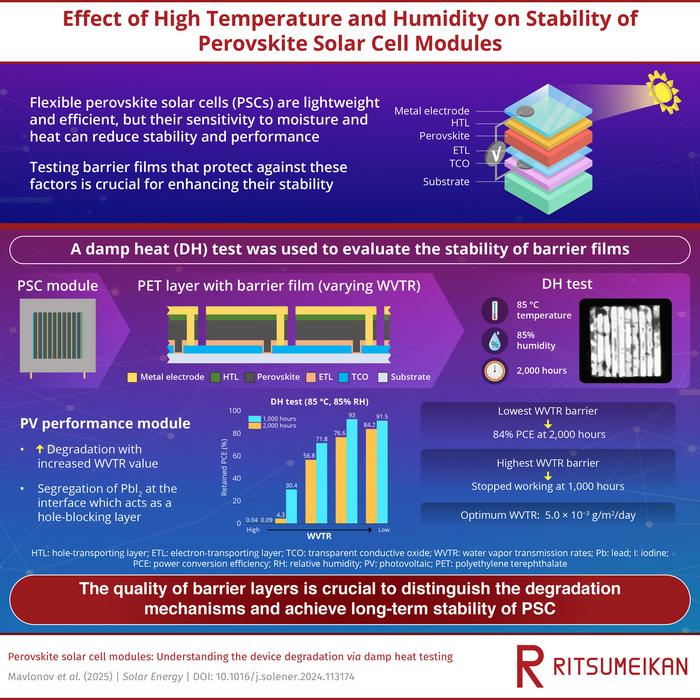
Researchers from Japan have recently made significant strides in the understanding of the longevity and durability of perovskite solar cells (PSCs), which are regarded as some of the most promising candidates for the future of renewable energy. The combination of high efficiency, light weight, and flexibility makes perovskite solar cells an attractive alternative to conventional silicon solar panels. However, their performance is often undermined by environmental factors like heat and humidity, which can lead to faster degradation of these materials.
This groundbreaking study, conducted under the leadership of Professor Takashi Minemoto from Ritsumeikan University, highlights the employment of a thorough damp heat test to evaluate the durability of methylammonium lead iodide-based PSC modules in harsh conditions that mimic real-world outdoor scenarios. Published in the highly regarded journal Solar Energy, the research is pivotal as it underscores the vital role that barrier films play in maintaining the stability and performance of flexible perovskite solar modules.
The catalyst behind this extensive research endeavor stems from the increasing urgency to harness alternative energy solutions efficiently. With global ambitions directed at curbing greenhouse gas emissions, the development of next-generation renewable energy technologies becomes paramount. Perovskite solar cells, in particular, promise unique manufacturing processes such as low-temperature wet-coating, which lends itself seamlessly to flexible substrates. This flexibility allows for innovative applications, especially in contexts with weight constraints or where conventional, rigid solar panels may not fit.
Throughout the investigation, the researchers utilized PSC modules encapsulated with varying water vapor transmission rates (WVTR) barrier films. This meticulous approach enabled them to discern how different materials affect the longevity of the modules when subjected to extreme conditions. The damp heat test involved exposing the modules to a relentless 85 °C temperature combined with 85% relative humidity—conditions designed to simulate prolonged exposure to real-world environments.
Over the course of 2,000 hours under these rigorous conditions, researchers monitored the photovoltaic performance of the modules. They achieved this by recording various parameters, including current-voltage characteristics, spectral reflectance, and electroluminescence. Such detailed analysis allowed the team to quantify the degradation suffered during the experiment, providing invaluable insights into PSC stability.
The results of the study were telling. The high humidity conditions led to the decomposition of the methylammonium lead iodide layer into lead iodide, a change detrimental to the charge transport capabilities across the layers. This degradation phenomenon not only inhibited the solar cell’s efficiency but illustrated how moisture exposure can severely compromise performance. Consequently, the performance metrics of the PSC modules were significantly affected, reinforcing concerns regarding environmental resilience.
One of the most notable findings from the research was the role of the barrier film quality. The encapsulation with the lowest WVTR barrier, quantified at 5.0 × 10−3 g/m2/day, showed promising results—retaining approximately 84% of its power conversion efficiency even after the damp heat exposure. In stark contrast, modules characterized by higher WVTR values exhibited rapid degradation, often failing within just 1,000 hours. Such results emphasize the critical nature of material selection in the design and manufacture of robust solar cells.
Moreover, Professor Minemoto’s insights shed light on the research’s broader implications. He stated that the findings provide foundational knowledge for industries looking to improve the stability of PSC modules for diverse applications ranging from urban architecture to mobile renewable energy solutions. Given the escalating global demand for sustainable energy sources, the versatility of flexible PSCs serves as both a potential game-changer and a viable alternative to traditional solar technologies.
This research opens up avenues not only for improving the current understanding of perovskite solar cells but also for fostering innovation in the solar industry. By enhancing the durability of these modules, researchers aim to extend the operational life and performance of solar technologies across various environments, ultimately supporting the transition to greener energy sources. The implications are far-reaching; they might very well expedite the shift towards a sustainable energy future across the globe.
To summarize, this rigorous study significantly contributes to the existing body of knowledge surrounding perovskite solar cells, particularly in regard to their durability under adverse environmental conditions. Insights gained from the research underscore the relevance of barrier film quality in developing reliable solar energy solutions and highlight the multifaceted applications of flexible solar technologies.
With ongoing efforts to optimize perovskite solar cells for enhanced performance, researchers not only seek to improve energy generation efficiency but also the broader application of renewable energy technologies in combatting climate change. The move towards cleaner energy is not just a technological advancement but an essential strategy for securing a sustainable future for generations to come.
In conclusion, as the world faces mounting environmental challenges, research like that conducted by Professor Minemoto and his team becomes essential. It not only reflects a dedicated effort towards innovation in renewable energy technologies but also serves as a guide for future ecological developments in solar energy applications. Their research brings hope that enhanced methods in energy generation can indeed pave the way for a cleaner, sustainable planet.
Subject of Research: Durability of perovskite solar cells
Article Title: Perovskite Solar Cell Modules: Understanding the Device Degradation via Damp Heat Testing
News Publication Date: January 15, 2025
Web References:
References:
Image Credits: Prof. Takashi Minemoto from Ritsumeikan University, Japan
Keywords
Perovskite solar cells, durability, renewable energy, barrier films, photovoltaic performance, environmental factors, innovation, sustainability, flexible solar technologies.
Tags: barrier films in solar technologydamp heat testing for solar cellsenhancing stability of PSCsenvironmental factors affecting solar cellsflexible solar panel innovationslong-term performance of solar modulesmethylammonium lead iodide PSCsnext-generation renewable energy solutionsperovskite solar cells durabilityrenewable energy advancementssolar energy journal publicationsTakashi Minemoto research





